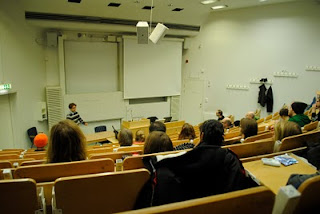I've noticed that some people have trouble understanding the idea of holons and how a holonic society works. As the idea of holons forms an important part of the socioeconomic design that EOS presents I thought I would try an present an overview of the idea in the hope it clarifies some points.
The whole idea of holons comes from observations of nature so in proposing a holonic structure EOS presents a structure that emulates nature. Nature organises herself in a bit of a different way to humans and I suspect that the main problem people have with the holonic concept stems from this difference. People tend to form hierarchies around a leader and when people come to EOS they tend to look for a centralised leadership; "show me my leader and I'll pledge obedience". However, a holonic system has no centralised leadership. This doesn't mean that it has no leaders at all but it means we have no one overall leader. Instead we have a distributed form of governance.
A holonic system has a number of groups or organisations and individuals that form a network. Each group within the network runs itself the way that it wants to. Which means it can have leaders within the group or not, depending on the group.
What keeps the whole thing together? In a word; goals. The whole system, exists to achieve a goal. In the case of EOS we aim for an overall goal of a sustainable, technological, moneyless society that offers a high standard of living for everyone. We aim to achieve this through the appliance of science to society. Each group in the network can work towards its own goals its own way so long as those goals fit in with the overall goal. We do envision that groups will work on projects so will have some kind of project leader and coordinators to help cooperation with other groups. These act to achieve the goals of the group. We also envision people having technical expertise in each group and the technical experts will make the decisions within their domain.
All the groups within the network cooperate; each putting something into the network and each getting something out of it in a symbiotic relationship (again, like in nature). When two or more groups find that they have something in common they can elect to work together on that common project. In doing so they form a new group higher up the holarchy. This enables multiple groups to combine resources to efficiently achieve a common goal. Those higher up holons can form, themselves, other higher up holons. Much like cells in a body form organs which in turn form a body.
Where groups differ with other groups they can go their own way and do their own thing, within the limits of the overall goal. A holonic system allows diversity and differences and sees them as strengths. We do not see the need to control everyone nor have everyone do the same thing; people have a great deal of freedom to get on and do things with out having to have someone to stand over them and constantly tell them what to do. Thus, we accept groups that have their differences and welcome that difference. This allows us to test out new ideas and explore other alternatives. So EOS doesn't need to dominate other groups nor absorb them into EOS. Pick a project you would like to work on. Does it fit in with the goal (check with a director if unsure). Yes? Then get on with it!
The system does have a hierarchy of functional sequences on the side. This structure has appointed directors that match onto the holarchy. The directors have the job of ensuring communications between groups and ensuring that each group has compatible goals but the directors do not interfere with the internal running of the group.
 |
| The Terran Technate as of early 2011 |
For more on holons see:

